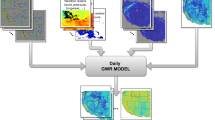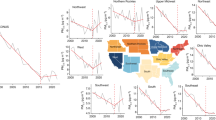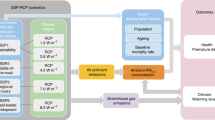Abstract
Many epidemiological studies use predicted air pollution exposures as surrogates for true air pollution levels. These predicted exposures contain exposure measurement error, yet simulation studies have typically found negligible bias in resulting health effect estimates. However, previous studies typically assumed a statistical spatial model for air pollution exposure, which may be oversimplified. We address this shortcoming by assuming a realistic, complex exposure surface derived from fine-scale (1 km × 1 km) remote-sensing satellite data. Using simulation, we evaluate the accuracy of epidemiological health effect estimates in linear and logistic regression when using spatial air pollution predictions from kriging and land use regression models. We examined chronic (long-term) and acute (short-term) exposure to air pollution. Results varied substantially across different scenarios. Exposure models with low out-of-sample R2 yielded severe biases in the health effect estimates of some models, ranging from 60% upward bias to 70% downward bias. One land use regression exposure model with >0.9 out-of-sample R2 yielded upward biases up to 13% for acute health effect estimates. Almost all models drastically underestimated the SEs. Land use regression models performed better in chronic effect simulations. These results can help researchers when interpreting health effect estimates in these types of studies.
This is a preview of subscription content, access via your institution
Access options
Subscribe to this journal
Receive 6 print issues and online access
$259.00 per year
only $43.17 per issue
Buy this article
- Purchase on Springer Link
- Instant access to full article PDF
Prices may be subject to local taxes which are calculated during checkout

Similar content being viewed by others
References
Brook RD, Rajagopalan S, Pope 3rd CA, Brook JR, Bhatnagar A, Diez-Roux AV et al. Particulate matter air pollution and cardiovascular disease: an update to the scientific statement from the American Heart Association. Circulation 2010; 121: 2331–2378.
Brauer M, Hoek G, van Vliet P, Meliefste K, Fischer P, Gehring U et al. Estimating long-term average particulate air pollution concentrations: application of traffic indicators and geographic information systems. Epidemiology 2003; 14: 228–239.
Clougherty JE, Wright RJ, Baxter LK, Levy JI . Land use regression modeling of intra-urban residential variability in multiple traffic-related air pollutants. Environ Health 2008; 7: 17.
Liao D, Peuquet DJ, Duan Y, Whitsel EA, Dou J, Smith RL et al. GIS approaches for the estimation of residential-level ambient PM concentrations. Environ Health Persp 2006; 114: 1374–1380.
Jerrett M, Burnett RT, Ma R, Pope 3rd CA, Krewski D, Newbold KB et al. Spatial analysis of air pollution and mortality in Los Angeles. Epidemiology 2005; 16: 727–736.
Carroll RJ, Ruppert D, Stefanski LA, Crainiceanu C . Measurement Error in Nonlinear Models: A Modern Perspective. Chapman and Hall/CRC. 2006.
Gryparis A, Paciorek CJ, Zeka A, Schwartz J, Coull BA . Measurement error caused by spatial misalignment in environmental epidemiology. Biostatistics 2009; 10: 258–274.
Lopiano KK, Young LJ, Gotway CA . A comparison of errors in variables methods for use in regression models with spatially misaligned data. Stat Methods Med Res 2011; 20: 29–47.
Madsen L, Ruppert D, Altman NS . Regression with spatially misaligned data. Environmetrics 2008; 19: 453–467.
Szpiro AA, Sheppard L, Lumley T . Efficient measurement error correction with spatially misaligned data. Biostatistics 2011; 12: 610–623.
Remer LA, Kaufman YJ, Tanre D, Mattoo S, Chu DA, Martins JV et al. The MODIS aerosol algorithm, products, and validation. J Atmos Sci 2005; 62: 947–973.
Kloog I, Koutrakis P, Coull BA, Lee HJ, Schwartz J . Assessing temporally and spatially resolved PM2.5 exposures for epidemiological studies using satellite aerosol optical depth measurements. Atmos Environ 2011; 45: 6267–6275.
Kloog I, Nordio F, Coull BA, Schwartz J . Incorporating local land use regression and satellite aerosol optical depth in a hybrid model of spatiotemporal PM(2.5) exposures in the Mid-Atlantic states. Enviro Sci Technol 2012; 46: 11913–11921.
Lyapustin A, Martonchik J, Wang YJ, Laszlo I, Korkin S . Multiangle implementation of atmospheric correction (MAIAC): 1. Radiative transfer basis and look-up tables. J Geophys Res Atmos 2011; 116: D03210.
Lyapustin A, Wang Y, Laszlo I, Kahn R, Korkin S, Remer L et al. Multiangle implementation of atmospheric correction (MAIAC): 2. Aerosol algorithm. J Geophys Res Atmos 2011; 116: D03211.
Lyapustin A, Wang Y, Frey R . An automatic cloud mask algorithm based on time series of MODIS measurements. J Geophys Res Atmos 2008; 113: D16207.
Chudnovsky A, Tang C, Lyapustin A, Wang Y, Schwartz J, Koutrakis P . A critical assessment of high resolution aerosol optical depth (AOD) retrievals for fine particulate matter (PM) predictions. Atmos Chem Phys Discuss 2013; 13: 14581–14611.
Kloog I, Melly SJ, Ridgway WL, Coull BA, Schwartz J . Using new satellite based exposure methods to study the association between pregnancy PM(2).(5) exposure, premature birth and birth weight in Massachusetts. Environ Health 2012; 11: 40.
Szpiro AA, Paciorek CJ, Sheppard L . Does more accurate exposure prediction necessarily improve health effect estimates? Epidemiology 2011; 22: 680–685.
Basagana X, Aguilera I, Rivera M, Agis D, Foraster M, Marrugat J et al. Measurement error in epidemiologic studies of air pollution based on land-use regression models. Am J Epidemiol 2013; 178: 1342–1346.
Szpiro AA, Paciorek CJ . Measurement error in two-stage analyses, with application to air pollution epidemiology. Environmetrics 2013; 24: 501–517.
Zeger SL, Thomas D, Dominici F, Samet JM, Schwartz J, Dockery D et al. Exposure measurement error in time-series studies of air pollution: concepts and consequences. Environ Health Persp 2000; 108: 419–426.
Acknowledgements
We greatly appreciate A. Lyapustin (NASA Goddard Space Flight Center, Baltimore, Maryland, USA) and Y. Wang (University of Maryland, Baltimore) for their work in providing the MAIAC data set for 2003. This work was supported by US EPA grant 834798 and NIH grants ES007142, ES016454, ES020871, and ES000002. This publication’s contents are solely the responsibility of the grantee and do not necessarily represent the official views of the US EPA. Further, US EPA does not endorse the purchase of any commercial products or services mentioned in the publication.
Author information
Authors and Affiliations
Corresponding author
Ethics declarations
Competing interests
The authors declare no conflict of interest.
Additional information
Supplementary Information accompanies the paper on the Journal of Exposure Science and Environmental Epidemiology website
Supplementary information
Rights and permissions
About this article
Cite this article
Alexeeff, S., Schwartz, J., Kloog, I. et al. Consequences of kriging and land use regression for PM2.5 predictions in epidemiologic analyses: insights into spatial variability using high-resolution satellite data. J Expo Sci Environ Epidemiol 25, 138–144 (2015). https://doi.org/10.1038/jes.2014.40
Received:
Revised:
Accepted:
Published:
Issue Date:
DOI: https://doi.org/10.1038/jes.2014.40
Keywords
This article is cited by
-
Short-term exposure to PM2.5 and 1.5 million deaths: a time-stratified case-crossover analysis in the Mexico City Metropolitan Area
Environmental Health (2023)
-
Assessment and Spatial Distribution Mapping of Criteria Pollutants
Water, Air, & Soil Pollution (2022)
-
The effects of traffic-related air pollutants on chronic obstructive pulmonary disease in the community-based general population
Respiratory Research (2021)
-
Satellite Remote Sensing for Estimating PM2.5 and Its Components
Current Pollution Reports (2021)
-
Influence of exposure measurement errors on results from epidemiologic studies of different designs
Journal of Exposure Science & Environmental Epidemiology (2020)



